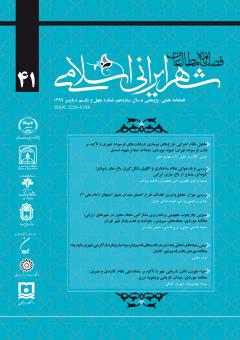بررسی و بازخوانی نظام ساختاری و الگوی شکلگیری باغ خان شوشتر؛ گونهای متمایز از باغ سازی ایرانی
محورهای موضوعی : شهرسازی اسلامی
محمدابراهیم مظهری
1
![]() ,
امین مقصودی
2
,
فاطمه پودات
3
,
امین مقصودی
2
,
فاطمه پودات
3
1 - استادیار، عضو هیات علمی گروه معماری دانشگاه شهید چمران اهواز، ایران
2 - دانشجوی دکتری معماری منظر، دانشکده معماری، پردیش هنرهای زیبا، دانشگاه تهران، تهران، ایران
3 - استادیار، عضوهیات علمی گروه معماری، دانشکده مهندسی عمران و معماری دانشگاه شهید چمران اهواز، اهواز، ایران
کلید واژه: باغ سازی ایرانی, باغ خان, شوشتر, باغ تک محوری, ساختار ارگانیک, کانال گرگر,
چکیده مقاله :
سنت باغ سازی در محدوده جغرافیایی ایران در طول چندین قرن همواره شامل گونههای ارزشمندی از باغ سازی نظیر باغ میوه، باغ رودخانه ای، باغ بیشه و... بوده که علی رغم دارا بودن خصوصیاتی منحصر به فرد، به دلیل تبعیت نکردن از الگوی جامع باغ ایرانی، کمتر مورد مطالعه و شناخت قرار گرفتهاند. باغ خان در شهر شوشتر، در مجاورت کانال تاریخی گرگر نمونه ای از این دست باغ سازی ایرانی است که به واسطه بستر قرار گیری خاص خود دربردارنده ویژگیهایی برجسته ای از باغ سازی ایرانی است. بر همین اساس، این پژوهش با رویکرد کیفی و با استفاده از روش تحقیقی توصیفی- تحلیلی تلاش خواهد نمود که به بررسی و شناخت مولفه ها و خصوصیات سازنده این باغ بپردازد. در این پژوهش به منظور شناخت و مستند سازی اطلاعات مرتبط با باغ خان نظیر اطلاعات طبیعی، تاریخی وکالبدی، از روش فهرست نگاری استفاده شده است. اطلاعات مورد نیاز عمدتا از طریق منابع کتابخانه ای از قبیل نوشته های تاریخی، اسناد و مدارک آرشیوی نقشه ها و تصاویر هوایی گرد آوری شده است. و همچنین در بخشی از فرایند جمع آوری اطلاعات، بررسیهای میدانی،مصاحبه های شفاهی نیز به کار گرفته شده اند. بر مبنای یافته های این پژوهش، باغ خان، باغی رودخانهای است که از نظر ساختاری میتواند در دسته باغهای تک محوری قرار گیرد. این درحالیست که به دلیل بستر ویژه قرار گیری باغ، این محور در راستایی غیر مستقیم واقع شده است که ضمن تاثیرگذاری بر نظامهای سازنده باغ، الگوی ساختاری غیر منتظم و ارگانیکی را برای باغ خان پدید آورده است. همچنین طبق یافتههای پژوهش فعالیتهای کشاورزی، تاثیرات فرهنگی دوره قاجار و همچنین خصوصیات بستر پیرامونی از مهم ترین عوامل اثرگذار در شکلگیری الگوی ساختاری باغ خان بودهاند.
Gardening tradition in the geographical area of Iran has included valuable types of gardens such as fruit garden, river garden, organic garden etc over past centuries. However, despite having unique features, because of the lack of compliance to the prevalent pattern of the Iranian Garden, these gardens have been relatively less studied and recognized. Khan garden in Shushtar, adjacent to the historic water canal of Gargar, is a remarkable example of such types of Iranian gardening since its unique context contains considerable features of gardening that are very unusual among other types of Iranian gardens. Accordingly, this research will try to study and recognize constructive components and elements of Khan garden through a qualitative approach and using the descriptive-analytical research method. In order to recognize and document information related to Khan garden like natural, historical and morphological data, the research applies the cataloguing technique. The required data are primarily collected through biblio sources such as historical accounts, archival documents, maps, aerial images. Also, field survey and oral interviews in the process of data collecting are employed. Based on research findings, the Khan garden should be perceived as a river garden and structurally could be classified as a uni-axial garden. However, since the specific context of the garden’s position, that axe has been placed on an indirect extension that affects constructive systems of the garden and provides an irregular and organic structure for that. Furthermore, according to other findings, agricultural activities, cultural influences of Qajar time, and surrounding characteristics have been the most significant factors in shaping the structural pattern of the Khan garden.
